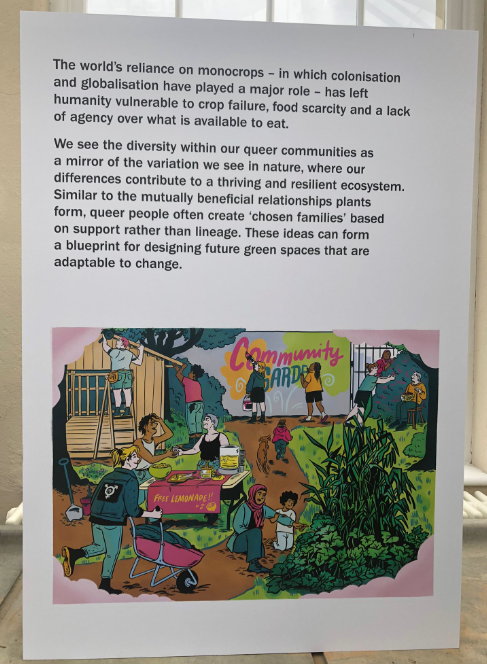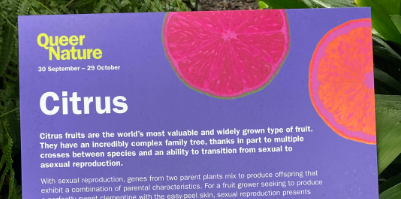Kew Gardens has been hosting a Queer Nature exhibition. “Looking at plants and fungi through a new lens sheds a light on the infinite diversity found in nature,” says the blurb. Kew Gardens is one of the world’s great institutions dedicated to the study and preservation of nature. So if anyone is going to do ‘Queer Nature’ well, it will be Kew. This exhibition is therefore going to be as good an exploration of queer nature and queer theory as you will get anywhere.
If you go into the exhibition knowing a little about queer theory, but seeking to learn more, you detect three threads.
The first is that while humans seek to categorise things, these categories sometimes have blurry boundaries. The trouble is that we know this already – queer theory doesn’t add anything. Often categories don’t have blurry boundaries. But at other times, they do. Humans have categorised clouds for example. Are cloud boundaries blurry? I expect they are not in their scientific definitions, but are in real life. So humans like to categorise things, and when boundaries are blurry, humans like to explore that blurriness, change the focus, to see if they can spot a sharp boundary somewhere after all. This is all obvious – and queer theory just doesn’t add anything new. Except that it seems to imply that there is someone out there trying to hide the fact that boundaries are sometimes blurry. Even perhaps, that someone is trying to exert political power by hiding the fact that boundaries are sometimes blurry. But there isn’t. Yet queer theory does entice young people into this conspiratorial way of thinking and the paranoid idea that there is some ‘other’ out there, trying to hide information or to exploit them.
The second thread that comes through in the exhibition is that not all forms of reproduction in nature involve two sexes and sexual reproduction. Again, the trouble is that most of us learned this at school. The exhibition has posters explaining non-sexual production in various plants. This is interesting, but, again, the gloss of queer theory doesn’t add anything at all. There is, again, the implication that someone somewhere was trying to hide plant variety. But nobody was. Queer theory states something obvious, with its only contribution being to overlay it with a degree of conspiratorial thinking.

The third thread is liberation. Queer theory – and Queer Nature – draw attention, as noted, to the fact that boundaries are blurry and that not all plants reproduce via sexual reproduction. Simple stuff that we knew. But there is a mood of new perspectives and liberation from pointing this out. This would be fine if there wasn’t that implied sense that someone somewhere had tried to hide information, impose constraints, from which the liberation. But nobody was.
There are some beautiful fabrics displayed. There are the posters explaining plant reproduction. The centrepiece of the exhibition is a video in which Kew employees and associates explain what queer nature means to them. It’s mostly from this that I have teased out the three strands above: two things that we know; the conspiratorial overlay, then the liberation from it. Queer theory contains nothing new, explains nothing, but has this paranoid overlay of implied hidden information, attempt at repression. The gullible are misled into believing in an ill-defined repressive ‘other’ out there somewhere – and this type of belief usually leads to people behaving badly.
Nevertheless, I came away from the Queer Nature exhibition thinking that Kew Gardens has done the world an unexpected favour – though not in the way intended. A great science-based institution has aimed to take queer theory seriously. It has thrown time, resources and expert staff knowledge, at queer theory. It has aimed to showcase queer theory’s insights and its explanatory power. And it has exposed that there is nothing there.

Perhaps we should encourage all institutions to take such a deep dive into queer theory. We will see them, too, come back with nothing. Because while clouds have blurry boundaries, humans do not. While mushrooms might reproduce asexually, humans do not. Queer theory does not help us to explain the human condition, nor does it help to solve policy issues. Women still want single-sex spaces even if mushrooms are asexual.
Caroline Ffiske is a Director of Conservatives for Women. Find her on X (Twitter).
Stop Press: Policy Exchange has also taken a pop at the Kew Gardens’ Queer Nature exhibition in its latest History Matters Report. It quotes Jerry Allen Coyne, a Professor Emeritus at the University of Chicago in the Department of Ecology and Evolution, who said:
The fact that flowers are hermaphrodites doesn’t either buttress or denigrate ‘queerness’. These are hermaphrodites, and hermaphrodites are not known in humans in a form that is fertile as both male and female. (We do have some human hermaphrodites, but they are almost vanishingly rare and are never fertile as both male and female.) …
They also mention fungi, which have ‘mating types’ that can number in the hundreds, but this is the exception among organisms and not seen as ‘sexes’ by biologists.











To join in with the discussion please make a donation to The Daily Sceptic.
Profanity and abuse will be removed and may lead to a permanent ban.